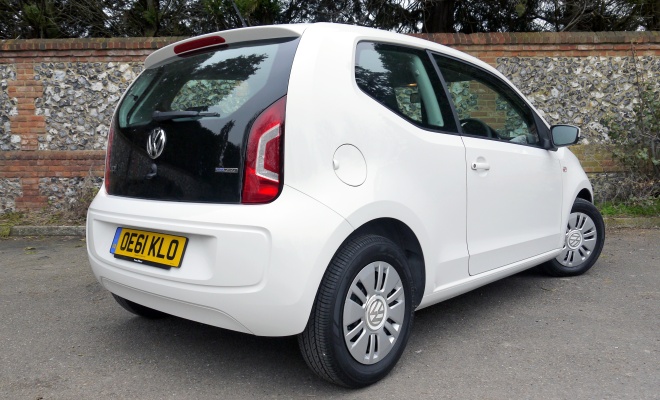
Testing VW’s City Emergency Braking system turns out to be harder than I expected.
It sounds simple enough: aim a brand new Volkswagen Up at a brick wall, get up to 10mph, and see what happens. But your instincts scream “brake” as the bricks loom large, and it takes a conscious effort of will to keep feet off the pedals and trust that the system, which uses an invisible laser beam to detect solid objects up to 10 metres in front of the car, will step in to avoid a crunch.
At what feels like the last possible moment, the car performs its own violent emergency stop, throwing me hard against my seatbelt. The system is deliberately designed to intervene in this uncomfortable way at up to 18mph, so that it continues to serve as a last resort rather than lulling the driver into overreliance.
So the little Up remains unscathed, as does the wall, which is only polystyrene.

I’m testing VW’s new city car in BlueMotion Technology guise. It’s the most economical car in the Up lineup – and also the most miserly petrol car in VW’s entire range.
It achieves 68.9mpg and CO2 output of 96g/km on the combined cycle test, reaping the benefits of a sub-100g/km result. Those plus points include zero road tax and waived London congestion charges.
Available only in mid-rank “Move Up” trim, the BlueMotion Technology edition starts at £9,330 on the road. The City Safety System seems like a worthwhile box to tick at just £225, and similarly the detachable “Maps & More” satnav and information screen that sprouts from the top of the dashboard is a reasonable £275 option.

The BlueMotion version is the only Up to duck under 100g/km, a score achieved through the fitment of automatic stop-start, eco tyres and an alternator set up to capture braking energy. If ordered without these clever fuel-saving measures, the Move Up model will cost £360 less but will emit a no-cigar 105g/km. Either way, the 60PS (59bhp) engine will take a leisurely 14.4 seconds to reach 62mph and will top out around 100mph, meaning the BlueMotion edition has not been subjected to any silly gearing changes in search of better economy.
It’s good to see that the BlueMotion car is not sold with rows of blank spaces on the dashboard – the mid-range trim brings manual air conditioning, remote central locking, electric windows, and a full ESP stability system with traction control and a barely necessary ability to distribute power to the front wheels according to grip. There are also body-coloured mirrors and door handles, which are evidently still considered worth mentioning in VW’s world.
A spare wheel is a £50 option, and the 250-litre boot looks cramped but is actually pretty capacious for this class of car. There is a useful double-deck boot floor, and the parcel shelf flips and clips up, rather than lifting on strings with the tailgate. This oddity does mean you tend to slam the hatch with the parcel shelf still sticking up, which you’ll only remember when you look in the rear-view mirror and can’t see anything
On the road, the 59bhp engine feels adequate to haul around the Up’s 940kg mass, but no more. Steep hills will require a low gear and 5,000rpm to cajole full steam ahead from the 999cc, three-cylinder engine room. And even with the little motor thrashing away you may still find other drivers tailgating you up the steepest bits.

The cabin is comfortable, classy and surprisingly spacious for such a small car. Getting settled is simple up front, although the rear is predictably pokey and a little claustrophobic too, a feeling worsened by the tall front seats with their integrated head restraints.
The flat-bottomed, thin-rimmed steering wheel is adjustable for height but not reach, while the driver’s seat ratchets up and down over a remarkable range. I got fed up inching downward before I’d plumbed the bottom.
The dashboard fascia is finished in a glossy plastic that looks appealing and retro but quickly proves a little annoying. Once in motion, the curved shiny surface picks up reflections of passing buildings and trees, creating an unwelcome distraction in your peripheral vision. I’m sure you’d quickly learn to blot it out.
The BlueMotion Up rides very well for a small, cheap car – noticeably better on its 65-profile tyres and 14-inch steel wheels than the posher High Up edition with its 15-inch alloys.
Nothing about the car feels remotely sporty but it is nonetheless great fun to drive. It is agile and darty, and you feel much more connected to the road than in the vast majority of more spirited modern machinery.

The BlueMotion Up turns out to be very easy to like, particularly as one of a growing number of eco cars that don’t feel like you’ve paid extra to wear an uncomfortably hairy shirt.
The Up’s biggest problem may well be price – specifically the fact that virtually identical cars from Seat and Skoda will cost hundreds of pounds less.
No doubt the saucer-sized VW roundel on the nose will persuade many buyers that it’s worth spending a little extra to own an Up.
VW Up review – BlueMotion Technology edition
18 March 2012
Read more about: fuel economy small cars test drives Under 100g/km Volkswagen



